操作系统概念(英文
操作系统概念(英文)

October 2012 Operating System Concepts- Chapter4 Threads 10
a traditional process as a single-thread
more than one thread in one process
Fig.4.1 Single and Multithreaded Processes
+
resource shared by all threads in the process
Traditional process, also named heavyweight process, has a single thread of control A thread is also called a lightweight process (LWP)
October 2012 Operating System Concepts- Chapter4 Threads 9
Basic concepts (cont.)
线程内容 tID 程序计数器 堆栈 寄存器组 状态 子线程
进程内容 PID 地址空间 全局变量 打开文件 子进程 定时器 信号 信号量 记账信息
October 2012
Operating System Concepts- Chapter4 Threads -
3
4.1 Overview
4.1.1Why thread needed As described in Chapter 3, the process is as the unit of resource allocation unit of CPU scheduling The costs of process management, such as costs of process creation, cancellation, process switch and process communication, are somewhat high, refer to Fig.3.4, and the concurrency (or multiprogramming degree) may be limited. To reduce costs of process management and improve degrees of concurrency and parallelism, the thread is presented
操作系统概念(英文)——大纲及总结
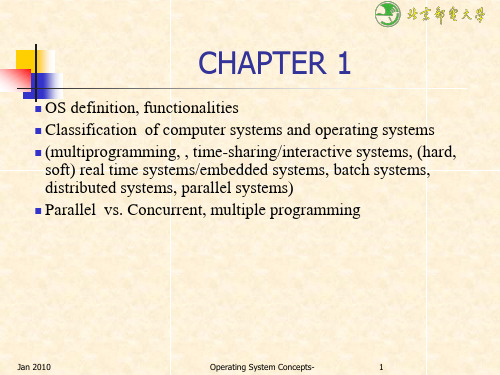
CPU
main memory
summary
OS
DOS
features
simple/ill-structured
Unix
Mach OS2
kernel
micro-kernel layered
Solaris
Windows NT/XP, Mac OS X
Jan 2010
module
(micro-)kernel + layered
accounting User interfaces file system manipulation I/O operations program Execution (dynamic) resource allocation protection and security
services
(§2.1) (§1.2) hardware
Jan 2010
Operating System Concepts-
1
CHAPTER 1
Interrupt vs. trap(陷阱、内部中断) Storage structure and hierarchy caching, Fig. 1.4 Dual mode operation and privileged instructions (1.5) System call
communication
error detection
OS components/functions
networking
Command-interpreter system
file
management Secondary storage management
操作系统概念(英文)
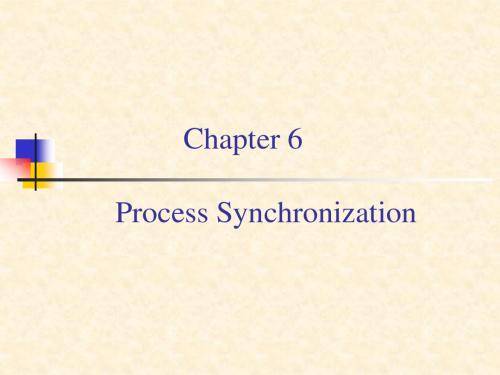
Oct. 2012
Operating System Concepts- Chapter 6 Process Synchronization -
2
An Introduction to Chapter 6 (cont.)
Processes/programs synchronizing mechanisms on application program-level software algorithms (§6.3) (*了解*) on hardware-level synchronization hardware (§6.4) (*了解*) on OS-level semaphores (信号量,§6.5) (*精通*) on programming environments or system software-levels high-level language synchronization constructs, including — monitors (管程§6.7) (*掌握*)
Oct. 2012
Operating System Concepts- Chapter 6 Process Synchronization -
10
Producer-consumer problem (cont.)
counter is shared data, the statements counter++; counter--; must be performed atomically Atomic operation means an operation that completes in its entirely without interruption. Otherwise, data inconsistency will occur. An Example. Executing of counter++ and counter -- atomically the statement ―count++‖ may be implemented in machine language as: register1 = counter register1 = register1 + 1 counter = register1
操作系统概念(第七版_英文版)ch3
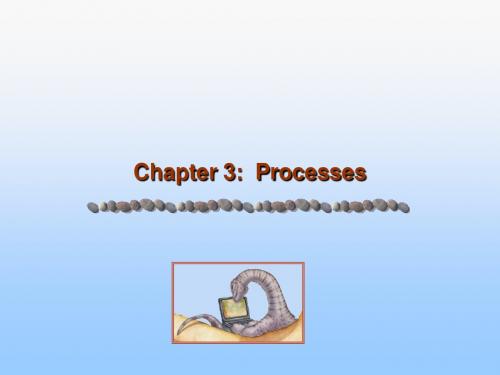
Operating System Concepts - 7th Edition, Feb 7, 2006
3.21
Silberschatz, Galvin and Gagne ©2005
Process Termination
Process executes last statement and asks the operating system to
Operating System Concepts - 7th Edition, Feb 7, 2006
3.2
Silberschatz, Galvin and Gagne ©2005
Process Concept
An operating system executes a variety of programs:
Short-term scheduler is invoked very frห้องสมุดไป่ตู้quently (milliseconds)
(must be fast)
Long-term scheduler is invoked very infrequently (seconds,
minutes) (may be slow)
Operating System Concepts - 7th Edition, Feb 7, 2006
3.5
Silberschatz, Galvin and Gagne ©2005
Process Control Block (PCB)
Information associated with each process
while switching
Time dependent on hardware support
名词解释 操作系统

名词解释操作系统
操作系统(英语:Operating System,缩写:OS)是一组主管并控制计算机操作、运用和运行硬件、软件资源和提供公共服务来组织用户交互的相互关联的系统软件程序。
根据运行的环境,操作系统可以分为桌面操作系统,手机操作系统,服务器操作系统,嵌入式操作系统等。
操作系统是人与计算机之间的接口,也是计算机的灵魂。
在计算机中,操作系统是其最基本也是最为重要的基础性系统软件。
从计算机用户的角度来说,计算机操作系统体现为其提供的各项服务;从程序员的角度来说,其主要是指用户登录的界面或者接口;如果从设计人员的角度来说,就是指各式各样模块和单元之间的联系。
事实上,全新操作系统的设计和改良的关键工作就是对体系结构的设计,经过几十年以来的发展,计算机操作系统已经由一开始的简单控制循环体发展成为较为复杂的分布式操作系统,再加上计算机用户需求的愈发多样化,计算机操作系统已经成为既复杂而又庞大的计算机软件系统之一。
操作系统概念OperatingSystemconcepts
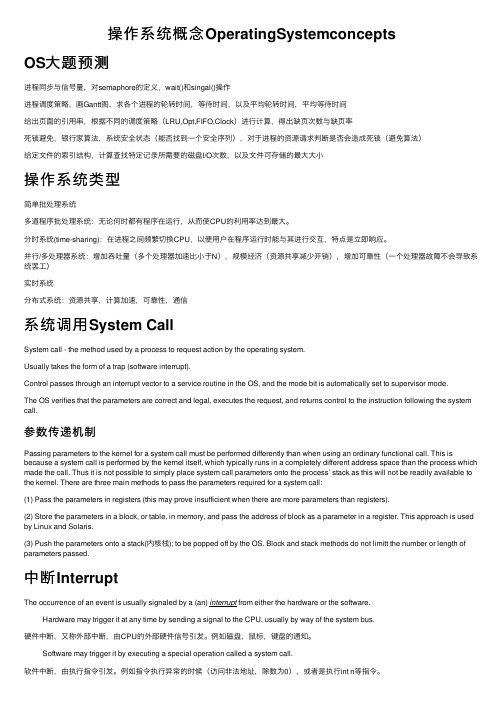
操作系统概念OperatingSystemconceptsOS⼤题预测进程同步与信号量,对semaphore的定义,wait()和singal()操作进程调度策略,画Gantt图,求各个进程的轮转时间,等待时间,以及平均轮转时间,平均等待时间给出页⾯的引⽤串,根据不同的调度策略(LRU,Opt,FIFO,Clock)进⾏计算,得出缺页次数与缺页率死锁避免,银⾏家算法,系统安全状态(能否找到⼀个安全序列),对于进程的资源请求判断是否会造成死锁(避免算法)给定⽂件的索引结构,计算查找特定记录所需要的磁盘I/O次数,以及⽂件可存储的最⼤⼤⼩操作系统类型简单批处理系统多道程序批处理系统:⽆论何时都有程序在运⾏,从⽽使CPU的利⽤率达到最⼤。
分时系统(time-sharing):在进程之间频繁切换CPU,以便⽤户在程序运⾏时能与其进⾏交互,特点是⽴即响应。
并⾏/多处理器系统:增加吞吐量(多个处理器加速⽐⼩于N),规模经济(资源共享减少开销),增加可靠性(⼀个处理器故障不会导致系统罢⼯)实时系统分布式系统:资源共享,计算加速,可靠性,通信系统调⽤System CallSystem call - the method used by a process to request action by the operating system.Usually takes the form of a trap (software interrupt).Control passes through an interrupt vector to a service routine in the OS, and the mode bit is automatically set to supervisor mode.The OS verifies that the parameters are correct and legal, executes the request, and returns control to the instruction following the system call.参数传递机制Passing parameters to the kernel for a system call must be performed differently than when using an ordinary functional call. This is because a system call is performed by the kernel itself, which typically runs in a completely different address space than the process which made the call. Thus it is not possible to simply place system call parameters onto the process’ stack as this will not be readily available to the kernel. There are three main methods to pass the parameters required for a system call:(1) Pass the parameters in registers (this may prove insufficient when there are more parameters than registers).(2) Store the parameters in a block, or table, in memory, and pass the address of block as a parameter in a register. This approach is used by Linux and Solaris.(3) Push the parameters onto a stack(内核栈); to be popped off by the OS. Block and stack methods do not limitt the number or length of parameters passed.中断InterruptThe occurrence of an event is usually signaled by a (an) interrupt from either the hardware or the software.Hardware may trigger it at any time by sending a signal to the CPU, usually by way of the system bus.硬件中断,⼜称外部中断,由CPU的外部硬件信号引发。
操作系统概念(英文)
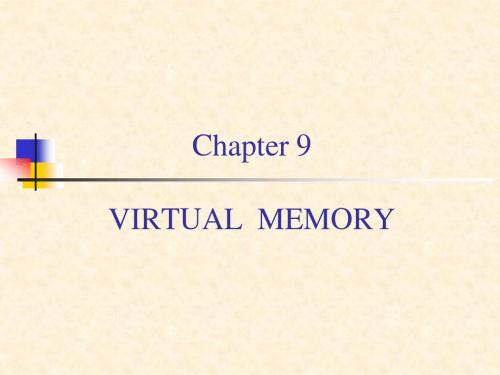
December 2012
Operating System Concepts - Chapter9 Virtual Memory -
3
An Introduction to Chapter 9 (cont.)
In multiprogramming VM systems, four issues must be addressed on when a process is to execute a instruction that is not in memory, OS loads the page or the segment in which the instruction exists by means of demand-paging(§9.2) or demand-segmentation. OS uses frame-allocation policies/algorithms (§9.5) to allocate free frames for the loaded pages, and a frame can be shared by more than one process in the system. if there are not enough free frames for allocation, OS uses page-replacement (§9.4) policies/algorithms to find some free frames.
Paging or segmentation vs. Demand paging or demand segmentation real memory schemes vs virtual memory schemes
操作系统概念(英文)
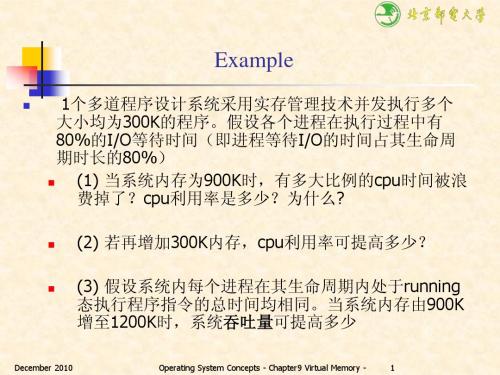
December 2010
Operating System Concepts - Chapter9 Virtual Memory -
2
Solution (cont.)
(2) 若再增加300K内存,系统可容纳4个进程同时并发执 行 4 此时,CPU的利用率为 (1— (80%) ) = (1— 0.4096) = 0.5904 所以,若再增加300K内存,cpu利用率可提高: (0.5904—0.488) / 0.488 = 20.98%
Operating System Concepts - Chapter9 Virtual Memory 1
December 2010
Solution
(1) 当系统内存为900K时, 系统可容纳3个进程同时并发执 行 根据题意,进程在执行过程中有80%的I/O等待时间, 表明进程等待I/O的时间占其生命周期时长的80%, 进 程处于waiting状态的概率为0.8 对系统内并发执行的n个进程, 当这n个进程同时处于 I/O等待时, cpu是空闲的 系统内3个并发进程同时处于I/O等待态而导致CPU空闲 的概率为(80%)3=0.512 因此,系统有51.2%的CPU时间被浪费掉了,系统CPU 的利用率为(1—51.2%)=48.8%。
Operating System Concepts - Chapter9 Virtual Memory 4
December 2010
December 2010
Operating System Concepts - Chapter9 Virtual Memory -
3
Solution (cont.)
(3)根据题意,设系统内每个进程在其生命周期内处于 running态执行程序指令的总时间均为T 当系统内存为900K时, 系统可容纳3个进程并发执行。如 果3个进程全部执行完所需时间为L3,则: CPU的利用率=3T / L3=48.8%, L3 = 3T / (48.8%), , 系统吞吐量Th3=3/ L3= (48.8%) / T 当系统内存由900K增至1200K时,系统可容纳4个进程 同时并发执行。设4个进程全部执行完所需时间为L4,则: CPU的利用率 = 4T / L4=59.04%, L4=4T / (59.04%), 系统吞吐量Th4=4/ L4= (59.04%) / T 因此,若再增加300K内存,系统吞吐量可提高: [(59.04%) / T —(48.8%) / T]/ [(48.8%) / T] = (0.5904—0.488) / 0.488 = 20.98% = 20.98%
1.0绪论
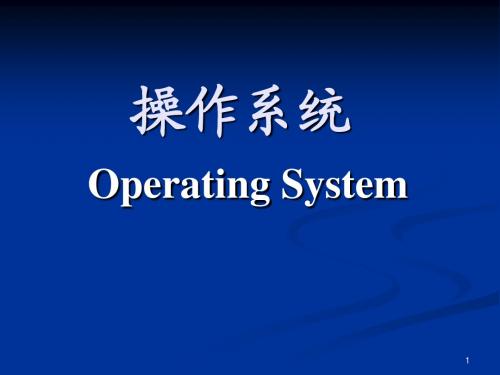
11
1.2.7操作系统的进一步发展 1.2.7操作系统的进一步发展 微机操作系统 多处理机操作系统 网络操作系统 分布式操作系统 嵌入式操作系统 以史明鉴,不是为了谈论历史而谈论历史, 以史明鉴,不是为了谈论历史而谈论历史, 而是明白OS为什么是现在这个样子, OS为什么是现在这个样子 而是明白OS为什么是现在这个样子,以及 将来会是什么样子
27
优点: 优点: 资源利用率高。资源指CPU及设备。 资源利用率高。资源指CPU及设备。 CPU及设备 系统吞吐量大。系统吞吐量指系统在 系统吞吐量大。 单位时间完成的总工作量 缺点: 缺点: 作业平均周转时间长:短作业的周转 作业平均周转时间长: 时间显著增长
28
采用多道程序设计提高了效率, 采用多道程序设计提高了效率,即 多道程序设计提高了效率 增加了单位时间的算题量, 增加了单位时间的算题量,但对每 道程序来说,却延长了计算时间。 道程序来说,却延长了计算时间。 要解决的问题:资源的竞争(CPU、 要解决的问题:资源的竞争(CPU、 内存)、内存的保护等。 )、内存的保护等 内存)、内存的保护等。
23
为了进一步提高资源的利用率和系统 对作业的吞吐量, 60年代中期 年代中期, 对作业的吞吐量,在60年代中期,引 入了多道程序设计技术, 入了多道程序设计技术,由此而形成 了多道批处理系统。 了多道批处理系统。
24
1.2.3 多道程序系统
操作系统发展史上革命性变革。 操作系统发展史上革命性变革。 多道程序设计技术: 在内存中放多道 多道程序设计技术 : 程序, 程序 , 使它们在管理程序的控制下相念
操作系统概念(第七版_英文版)ch2
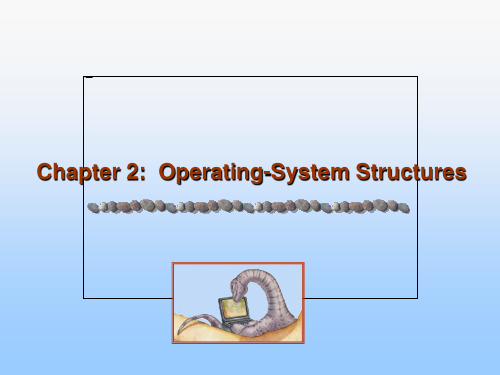
System Programs
Operating System Design and Implementation Operating System Structure Virtual Machines
Operating System Generation
System Boot
Operating System Concepts – 7th Edition, Jan 14, 2005
2.6
Silberschatz, Galvin and Gagne ©2005
User Operating System Interface - CLI
CLI(Command Line Interface) allows direct command entry
பைடு நூலகம்
processes, and other systems
To discuss the various ways of structuring an operating system To explain how operating systems are installed and customized
and how they boot
Operating System Concepts – 7th Edition, Jan 14, 2005
2.3
Silberschatz, Galvin and Gagne ©2005
Operating System Services
One set of operating-system services provides functions that are
Program Interface (API) rather than direct system call use
操作系统介绍与安装完整版

认识操作系统定义:操作系统(英语:Operating System,简称OS)是管理和控制计算机硬件与软件资源的计算机程序,是直接运行在“裸机”上的最基本的系统软件,任何其他软件都必须在操作系统的支持下才能运行。
操操作系统所处位置作系统是用户和计算机的接口,同时也是计算机硬件和其他软件的接口。
操作系统的功能:包括管理计算机系统的硬件、软件及数据资源,控制程序运行,改善人机界面,为其它应用软件提供支持等,使计算机系统所有资源最大限度地发挥作用,提供了各种形式的用户界面,使用户有一个好的工作环境,为其它软件的开发提供必要的服务和相应的接口。
操作系统的种类:各种设备安装的操作系统可从简单到复杂,可分为智能卡操作系统、实时操作系统、传感器节点操作系统、嵌入式操作系统、个人计算机操作系统、多处理器操作系统、网络操作系统和大型机操作系统。
按应用领域划分主要有三种:桌面操作系统、服务器操作系统嵌入式操作系统。
○1桌面操作系统桌面操作系统主要用于个人计算机上。
个人计算机市场从硬件架构上来说主要分为两大阵营,PC机与Mac机,从软件上可主要分为两大类,分别为类Unix操作系统和Windows 操作系统:1、Unix和类Unix操作系统:Mac OS X,Linux发行版(如Debian,Ubuntu,Linux Mint,openSUSE,Fedora 等);一个流行Linux发行版——Ubuntu桌面Mac OS X桌面2、微软公司Windows操作系统:Windows XP,Windows Vista,Windows 7,Windows 8等。
Windows 8 MetroWindows 8桌面○2服务器操作系统服务器操作系统一般指的是安装在大型计算机上的操作系统,比如Web服务器、应用服务器和数据库服务器等。
服务器操作系统主要集中在三大类:1、Unix系列:SUN Solaris,IBM-AIX,HP-UX,FreeBSD 等;2、Linux系列:Red Hat Linux,CentOS,Debian,Ubuntu 等;3、Windows系列:Windows Server 2003,Windows Server 2008,Windows Server 2008 R2等。
操作系统概念(英文)
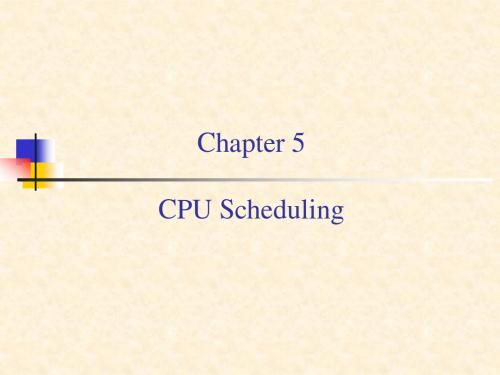
October 2012
Operating System Concepts-Chapter 6 CPU Scheduling -
3
5.1 Basic Concepts (cont.)
5.1.2 The cycle of process execution Process execution consists of a cycle of CPU execution and I/O wait, i.e., CPU burst and I/O burst e.g. Fig.5.1
October 2012
Operating System Concepts-Chapter 6 CPU Scheduling -
7
5.1 Basic oncepts (cont.)
5.1.3 Who conduct CPU Scheduling As components of OS, scheduler (§5.1.2) and dispatcher (§ 5.1.4, 分配器,调度器)are responsible for CPU scheduling
October 2012 Operating System Concepts-Chapter 6 CPU Scheduling 10
5.1 Basic Concepts (cont.)
Scheduling under condition 1 and 2 is nonpreemptive (非抢占 式), because the CPU becomes in idle All other scheduling is preemptive (抢占式), often used in real-time systems
操作系统概念(英文)——Syllabus for Operating Systems

Beijing University of Posts and Telecommunications (BUPT)School of Computer Science and TechnologySyllabus for Operating Systems1. OverviewsCourse No.: 313.04103 Course Title: Operating Systems Course Credit: 4 Credits, required courseSemester and Year: Fall 2008 Class: 06406—06410 Teaching hours:z Class teaching: 64 hoursz After-class experiments: 17 hoursz Course design, or professional practice for this course:(操作系统综合课程设计), 30 hours, 1 credits, conducted inthe 3rd semester.Prerequisites:z Data Structurez Computer Organization Principles2. Lecture MeetingsTime: Monday AM: 10:00 – 12:00Wensday AM: 10:00 – 12:00Location: Room 402, 4th Teaching Building3. FacultyInstructorz Name: Dr. Wen YE (叶文)z Office: Room 918, 3rd Teaching Buildingz Office Hours: Wednesday 3:00 to 4:30 PM,I am also available by appointment at a time more convenientfor you, especially at the end of this semesterz Phone: 86-10-62282633 (O)z E-mail: gryew@, yewen@Graduate Teaching Assistant:z Name: Cheng Yan (成艳),chengy352@Ma Haiying(马海印),mahaiyinmhy@ z Responsibility: checking homework, directing experimentsz Office: Room 918, 3rd Teaching Buildingz Office Hours: Wednesday 3:00 to 4:30 PM, or by appointment 4. Text Book1. Abraham Silberschatz, Peter Baer Galvin, Greg Gagne, Operating System Concepts(Seventh Edition), Higher Education Press and McGraw-Hill Companies, Beijing, May, 2007.References1.Andrew S.Tanenbaum, Modern Operating Systems, ChinaMachine Press and Prentice Hall, Beijing, Jan.1999.2.孙钟秀,费翔林,洛斌,谢立,操作系统教程(第3版),高等教育出版社,北京,2003年8月3.曹聪, 范廉明,操作系统原理与分析,科学出版社,北京,2003年9月。
操作系统概念(英文)

Process Concept (cont.)
3.1.5 Process vs program dynamic vs static process: lifecycle being created —— executing —— being deleted composition: program + data + PCB A program may correspond to several processes; a process may also contains several programs (e.g. main routines, subroutines and procedures )
The process is characterized with dynamic and concurrent features Roles of processes unit of running entity in system, i.e., CPU allocation unit of resource (e.g. memory, files, devices,…) allocation
3.1.2 Process Definition A process is a program in execution the unit of resources (CPU, memory, I/O devices) allocation runs concurrently with other processes
October 2012
Operating System Concepts- Chapter3 Processes -
19
§3.2 Process Scheduling
操作系统概念(英文)
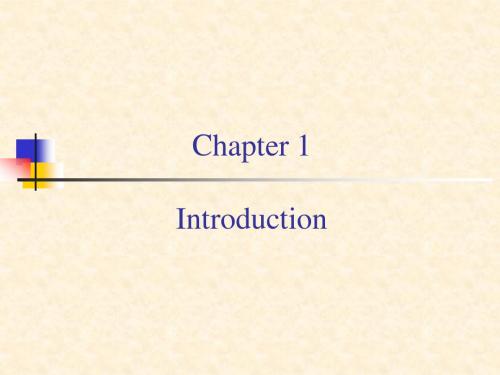
September 2012
§1.2 Computer-System Organization
1.2.1 Computer-System Operation Fig. 1.2 A modern computer system
Commonly acknowledged classifications of OS PC/Desktop OS : Windows, Linux,Mac OS X Server OS : Unix, Linux, Windows NT Mainframe OS : Unix, Linux——open source!! Embedded OS : Vxworks, (Palm OS), (Symbian), (WinCE)/Windows Mobile/Phone, Android, iOS, embedded Linux (e.g. μcLinux)
September 2012 Operating System Concepts- Chapter1 Introduction 8
1.1.2 OS Concepts (cont.)
For OS definitions in other textbooks, refer to Appendix 1.B OS definitions
September 2012
Operating System Concepts- Chapter1 Introduction -
3
Fig.1.1-1 Components of a computer system
Application Software
操作系统概念OPERATINGSYSTEMCONCEPTSSixthEdition课件

1.8 手持系统(handheld system)
个人数字助理(Personal Digital Assistants, PDAs)
蜂窝电话(Cellular telephones) 存在的问题
内存有限(32M – 64M) 低速处理器(只有个人计算机处理器速度的几
分之一) 屏幕小(5英寸×3英寸)
作业在内存与物理存储器之间来回交换(swap) 允许用户与系统之间的联机通信(交互)
当OS执行完一条命令后,它将接收用户通过键 盘输入的下一条控制指令。
联机系统必须提供给用户访问数据和代码。
10
1.3 桌面系统
PC - 为单个用户服务的计算机系统 I/O设备 - 键盘,鼠标,显示器,打印机等 用户方便性和响应性 可以采用大型操作系统上的技术
在若干个位于不同位置的处理器之间组成分布式计算 松耦合系统 (loosely coupled system) - 每个处理器都有自己
的内存;处理器相互之间通过不同的通信线路进行通信,如高速 总线或电话线 优点 资源共享 计算速度提高 可靠性 通信 需要网络基础结构 局域网(local-area network, LAN) 或 广域网(wide-are network, WAN) 根据节点间的距离来划分 可以是C/S系统或端对端系统
流水线
12
非对称处理(Asymmetric multiprocessing)
每个处理器被赋予一个特定的任务,主处理器为从处理 器调度和安排工作。
类似于超大型系统
对称处理(Symmetric multiprocessing, SMP)
每个处理器都运行同一个操作系统的拷贝,这些拷贝需 要互相通信
15
客户 - 服务器系统的通用结构
- 1、下载文档前请自行甄别文档内容的完整性,平台不提供额外的编辑、内容补充、找答案等附加服务。
- 2、"仅部分预览"的文档,不可在线预览部分如存在完整性等问题,可反馈申请退款(可完整预览的文档不适用该条件!)。
- 3、如文档侵犯您的权益,请联系客服反馈,我们会尽快为您处理(人工客服工作时间:9:00-18:30)。
Contents of Class Teaching(cont.)
Six parts in the textbook 1. (Part One) Overview(概论) Chapter1 OS definition, OS functionalities and types ( OS vs. various types of computer systems, developments of OS) Chapter2 running environments for OS , resources managed by OS Chapter3 OS structure, from view points of resource management and human-machine interaction(§3.1.1-3.1.8)
Syllabus for Operating Systems (cont.)
Course Contents
The teaching of Operating System includes three parts, i.e., In-class teaching of Operating System (64 teaching hours) Basic after-class experiments on Linux (17 teaching hours) Professional practice in Linux (about 10 days, 30 teaching hours), i.e. Course Design IBM精品课程
PART3 Body of Knowledge in Computer Science (Areas)
DS离散结构(72核心学时) PF程序设计基础(69核心学时) AL算法与复杂性(54核心学时) AR计算机组织与体系结构(82核心学时) OS操作系统(40核心学时) NC网络及其计算(48核心学时) PL程序设计语言(54核心学时) HC人机交互(12核心学时) GV图形学和可视化计算(8核心学时) IS智能系统(22核心学时) IM信息管理(34核心学时) SP社会与职业问题(11核心学时) SE软件工程(54核心学时) CN数值计算科学(无核心学时)
PART 1 Syllabus for Operating Systems
The syllabus is about basic information of this course, such as course overviews, lecture meetings, faculty, text book and references, course objects and curricula, assignments and projects, grading policy, and class policies, etc. for more details, see the file Syllabus for Operating Systems.doc attached Operating System is an essential part of operating system (OS) knowledge area specified in China Computing Curricula 2005 and Computing Curricula 2004 by ACM and IEEE/CS
《操作系统》课程教学中的Linux技术实践
Syllabus for Operating Systems(cont.)
With respect to in-class teaching, Linux is taken as a case study, its principles and key technologies are incorporated into the teaching contents, such as OS architectures process management, memory management, device management, and file systems, etc.. In parallel with course learning, each student is directed to make several basic after-class experiments on Linux independently, to get the students to have a better grasp of their knowledge about OS learned in the classes and become skilled at operating practical operating like Linux
IBM精品课程
操作系统
— 及其Linux技术实践
叶 文
北京邮电大学 计算机科学与技术学院 2008年9月,北京
Operating System Concepts
Application of Linux in Course Teaching and Professional Practice
YE Wen
PART 2 China Computing Curricula 2005
China Computing Curricula 2005 中国计算机科学与技术教程CCC2005 参照IEEE-CS&ACM制定的Computing Curricula 2004 知识与课程体系 14个知识领域 (areas),知识单元(unit) in areas, 知识点 (topics) in units 课程体系:基础课程,主干课程,特色课程
Syllabus for Operating Systems(cont.)
As the seamless part of computer discipline specified in China Computer Curriculum 2005, the professional practice of Operating systems course is conducted during the Summer short term (at the end of the second semester) on the basis of operating system principles and Linux they learned in course learning and basic experiments, the student teams are directed to design and develop a demos of communication-area-oriented real-time and embedded Linux — 实时嵌入式Linux系统关键技术 — covering the knowledge unit “OS9 real-time and embedded system”
Computer School Beijing University of Posts and Telecommunications
COURSE INTRODUCTION
Syllabus for Operating Systems China Computing Curricula 2005 (CCC2005) Body of Knowledge in Computer Science Knowledge Unites in Operating Systems Areas Contents of Class Teaching Why Linux as Case Studies Some issues to be emphasized
PART 4 Knowledge Unites in OS Areas
OS1操作系统概述(核心) OS2操作系统原理(核心) OS3并发性(核心) OS4调度与分派(核心) OS5内存管理(核心) OS6设备管理(核心) OS7安全与保护(核心) OS8文件系统(核心) OS9实时和嵌入式系统(选修) OS10容错(选修) OS11系统性能评价(选修) OS12脚本(选修)
Syllabus for Operating Systems(cont.)
In Beijing University of Posts and Telecommunications, Operating Systems is a required course for about 450 juniors majoring in computer science and technology according to the cultivation plans. This course is taught in Chinese and English, and the English textbook used is OPERATING SYSTEM CONCEPTS (Fourth Edition), written by Abraham Silberschatz, etc..
Contents of Class Teaching(cont.)
2. Resources Management Part Two, Part Three, and Part Four resources : hardware: CPU, memory, I/O devices software/Information: programs and data as files Part Two Process MaБайду номын сангаасagements — Chapter4, 5 Processes/Threads basic units for CPU managements CPU managements: scheduling, synchronization, deadlock processing — Chapter6 CPU scheduling of concurrent processes or threads)
